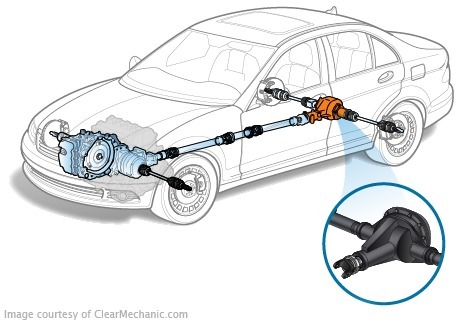
Freelance-based differential is a variation of high friction or LSD (Limited Slip Differential). Like any self-balancing, differential is a trade-off between a free differential and a differential full-lock, since, depending on traffic conditions, it can "turn" into one type or another. Design of the friction self-locking differential
Design of the friction self-locking differential
The action of the friction self-balancing differential is based on the change of angular velocity during rotation. In a straight line, the semiaxle rotates synchronously with the central part of the differential, but in the turn, when the difference is made in angular velocity, the "lagging" Semi-axis torque is greater by the friction between the gears and the differential hull. The friction between the differential hull and the semiaxial gears is what is called a friction, that is, a package assembled from discs made of the same material as part of the clutch. The Differential on the basis of the amusements requires periodic maintenance. The direct contact of the friction is worn out, the friction forces are reduced, resulting in the loss of the effectiveness of the lock. Due to the relative short-life of the design, the friction-based differential is rarely used in the transmission of serial machines.
Disk Differential Friction Type
The main kind of friction self-locking differential. This is a symmetrical differential with one or two friction discs. The packages are divided into two parts-half of the disks are tightly tied to the differential hull, the other half-with the semi-axis. When there is a difference in angular velocity, one of the package groups is part of the cordon.
How it works
The principle of high friction of disc-type friction is based on the friction forces arising from the difference between the rotational speed of one and the other half-axis. When the speed of rotation increases, the speed of the disks in the package begins to rotate faster, with friction-resistant friction between the discs mounted on the semi-axis and the hull. This torque shall be increased by the wheel volume which is free at that moment and the partial differential lock is reached.
The notion of preliminary thrust
The preliminary urge is the degree to which the friction packages are compressed. The more pennilty you are, the earlier the fries are in the cordon. With a large pretraction, the lock is triggered as soon as a difference is made in the axis rotation speed. The large pretension is widely used in blocks of cars intended for off-road or, for example, in the rear axle of cars intended for use by drifting. For driving in the daily operating mode, locking with a large pre-motive power is of little use, as it can lead to permanent drifting. It is possible to unblock a large pre-lock lock on a turntable on the road with a characteristic click or cracking.
When a lock is held on a lock with a large preload block, the disks are not first wrapped, the one wheel is bounded slightly, and the actuator is affected by the force that seeks to twist it. Then the torque is greater than the force of the friction discs, and they are running on a small angle because the drive is reactive. This is repeated and again, as long as the car passes the turn. Drivesdisk drives and cod.
Methods for installing the friction locking differential
The Friction Self-balancing differential (s), which are produced by a number of known tuning carts for various vehicles, are a block (a central part of the differential), which is installed in the gearbox or a gearbox instead of a normal free differential without additional rework. To be installed from the factory differential, the driven gears are swolvered and then swung to the installed self-locking differential.







